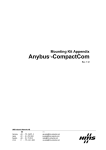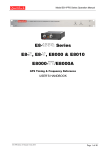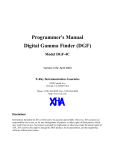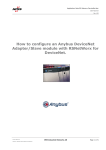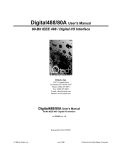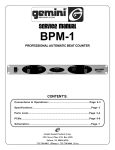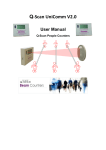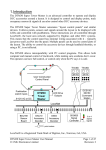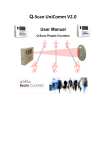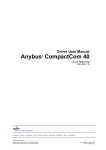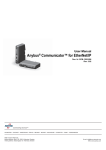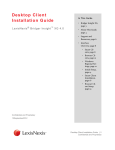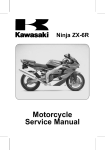Download Anybus-CompactCom Hardware Design Guide
Transcript
Hardware Design Guide Anybus CompactCom 30 ® Doc. Id. HMSI-168-31 Doc. Rev. 2.24 Twincomm de Olieslager 44 5506 EV Veldhoven the Netherlands T +31-(0)40-2301.924 F +31-(0)40-2301.923 E [email protected] www.twincomm.nl Connecting DevicesTM HALMSTAD • CHICAGO • KARLSRUHE • TOKYO • BEIJING • MILANO • MULHOUSE • COVENTRY • PUNE • COPENHAGEN HMS Industrial Networks Mailing address: Box 4126, 300 04 Halmstad, Sweden Visiting address: Stationsgatan 37, Halmstad, Sweden E-mail: [email protected] www.hms-networks.com Important User Information This document is intended to provide a good understanding of the mechanical and electric properties of the Anybus CompactCom platform. It does not cover any of the network specific features offered by the various incarnations of the product; this information is instead available as separate documents (Network Interface Appendix). The reader of this document is expected to be familiar with hardware design and communication systems in general. For more information, documentation etc., please visit the HMS web site, ‘www.anybus.com’. Liability Every care has been taken in the preparation of this manual. Please inform HMS Industrial Networks AB of any inaccuracies or omissions. The data and illustrations found in this document are not binding. We, HMS Industrial Networks AB, reserve the right to modify our products in line with our policy of continuous product development. The information in this document is subject to change without notice and should not be considered as a commitment by HMS Industrial Networks AB. HMS Industrial Networks AB assumes no responsibility for any errors that may appear in this document. There are many applications of this product. Those responsible for the use of this device must ensure that all the necessary steps have been taken to verify that the applications meet all performance and safety requirements including any applicable laws, regulations, codes, and standards. HMS Industrial Networks AB will under no circumstances assume liability or responsibility for any problems that may arise as a result from the use of undocumented features, timing, or functional side effects found outside the documented scope of this product. The effects caused by any direct or indirect use of such aspects of the product are undefined, and may include e.g. compatibility issues and stability issues. The examples and illustrations in this document are included solely for illustrative purposes. Because of the many variables and requirements associated with any particular implementation, HMS Industrial Networks AB cannot assume responsibility for actual use based on these examples and illustrations. Intellectual Property Rights HMS Industrial Networks AB has intellectual property rights relating to technology embodied in the product described in this document. These intellectual property rights may include patents and pending patent applications in the US and other countries. Trademark Acknowledgements Anybus ® is a registered trademark of HMS Industrial Networks AB. All other trademarks are the property of their respective holders. Warning: This is a class A product. In a domestic environment this product may cause radio interference in which case the user may be required to take adequate measures. ESD Note: This product contains ESD (Electrostatic Discharge) sensitive parts that may be damaged if ESD control procedures are not followed. Static control precautions are required when handling the product. Failure to observe this may cause damage to the product. Anybus CompactCom 30 Hardware Design Guide Rev 2.24 Copyright© HMS Industrial Networks AB Apr 2014 Doc Id HMSI-168-31 Table of Contents Table of Contents Preface About This Document Related Documents.................................................................................................................................. 5 Document History ................................................................................................................................... 5 Conventions & Terminology.................................................................................................................. 6 Support ...................................................................................................................................................... 6 Chapter 1 Introduction General Description................................................................................................................................. 7 Features...................................................................................................................................................... 7 Host Interface Overview......................................................................................................................... 8 Passive vs. Active ..................................................................................................................................... 8 M12 Connector......................................................................................................................................... 9 Chapter 2 Host Connector Host Interface Signals............................................................................................................................ 10 Signal Descriptions................................................................................................................................. 12 OM[0...2] (Operating Mode) ........................................................................................................ 12 MI[0...1] (Module Identification)................................................................................................... 12 RESET (Reset Input)................................................................................................................... 13 MD[0...1] (Module Detection) ...................................................................................................... 14 Parallel Interface ............................................................................................................................ 14 Serial Interface ............................................................................................................................... 14 Safety Serial Interface (PROFINET 2-port only).......................................................................... 14 Network Status LED Outputs ..................................................................................................... 15 General Purpose I/O..................................................................................................................... 15 Chapter 3 Parallel Interface Operation General Information.............................................................................................................................. 16 Parallel Interface Signals........................................................................................................................ 17 Function Table (CE, R/W, OE, D[0...7]) .......................................................................................... 17 Timing Diagrams.................................................................................................................................... 18 Read Access Timing....................................................................................................................... 18 Write Access Timing...................................................................................................................... 19 Network Identification .......................................................................................................................... 20 Chapter 4 Serial Interface Operation General Description............................................................................................................................... 21 Serial Interface Signals........................................................................................................................... 21 Baud Rate Accuracy ............................................................................................................................... 21 Chapter 5 General Purpose I/O General..................................................................................................................................................... 22 Functional Description.......................................................................................................................... 22 Appendix A Implementation Guidelines Module Compatibility ............................................................................................................................ 23 Additional Address Lines (A[11...13])................................................................................................. 23 Network Status LED Outputs (LED[1A...2B]) ................................................................................ 24 Typical Implementation (3.3V) ............................................................................................................ 25 Interfacing to 5V Logic ......................................................................................................................... 26 Power Supply Considerations............................................................................................................... 27 General.......................................................................................................................................... 27 Bypass Capacitance ........................................................................................................................ 28 3.3V Regulation ........................................................................................................................... 28 Appendix B Mechanical Specification Overview ................................................................................................................................................. 29 M12 Connector....................................................................................................................................... 30 Footprint.................................................................................................................................................. 31 Housing Preparations ............................................................................................................................ 32 Slot Cover................................................................................................................................................ 33 Host Connector...................................................................................................................................... 34 Host Connector Considerations....................................................................................................... 36 Host Connector Pin Numbering..................................................................................................... 36 Fastening Mechanics.............................................................................................................................. 37 Appendix C Technical Specification Environmental ........................................................................................................................................ 38 Shock and Vibration .............................................................................................................................. 38 Electrical Characteristics ....................................................................................................................... 39 Regulatory Compliance ......................................................................................................................... 40 Preface P. About This Document For more information, documentation etc., please visit the HMS website, ‘www.anybus.com’. P.1 Related Documents Document Anybus CompactCom Software Design Guide Anybus CompactCom Driver User Manual Anybus CompactCom 30 Network Appendix (separate document for each supported fieldbus system) Anybus CompactCom Brick and without Housing Design Guide Low-Cost, Low-Power Level Shifting in Mixed-Voltage (5V, 3.3V) Systems (SCBA002A) LT1767 Data sheet EN 60950 EN 61000 EN 55011 Author HMS HMS HMS HMS Texas Instruments Linear Technology European Union European Union European Union P.2 Document History Summary of Recent Changes (2.23... 2.24) Change Added service mode in chapter 2.2.1 Updated support information Page(s) 12 6 Revision List Revision 1.00 - 1.25 2.00 2.10 2.11 2.12 2.20 2.21 2.22 2.23 2.24 Date Author 2010-05-31 2012-02-29 2012-05-25 2012-05-31 2012-09-13 2013-04-02 2013-05-13 2014-01-28 2014-04-01 KeL KeL KeL KeL KeL KeL KaD KeL KaD Chapter(s) Description See earlier revisions All Major update 2, 3, A Updates B Minor update B Minor correction 1, 2, B New connector type, minor corrections 2, 5 Minor update P, B Minor update 1, 2 Added info on functional safety, minor corrections 2 Minor updates Anybus CompactCom 30 Hardware Design Guide Doc.Rev. 2.24 Doc.Id. HMSI-168-31 About This Document 6 P.3 Conventions & Terminology The following conventions are used throughout this manual: • Numbered lists provide sequential steps • Bulleted lists provide information, not procedural steps • The term ‘Anybus’ or ‘module’ refers to the Anybus CompactCom. • The terms ‘host’ or ‘host application’ refers to the device that hosts the Anybus module. • Hexadecimal values are written in the format NNNNh or 0xNNNN, where NNNN is the hexadecimal value. • A byte always consists of 8 bits. • All measurements in this document have a tolerance of ±0.20mm unless otherwise stated. • Outputs are TTL compliant unless otherwise stated. • Signals which are ‘pulled to NN’ are connected to NN via a resistor. • Signals which are ‘tied to NN’ are directly connected to NN. P.4 Support For general contact information and support, please refer to the contact and support pages at www.anybus.com. Anybus CompactCom 30 Hardware Design Guide Doc.Rev. 2.24 Doc.Id. HMSI-168-31 Chapter 1 1. Introduction 1.1 General Description The Anybus CompactCom network communication module is a high performance, low cost communication solution for industrial field devices. All Anybus CompactCom implementations share the same footprint and electrical interface, allowing the host application to support all major networking systems using the same hardware platform. Two different host interface options are provided, serial and parallel, allowing easy integration into almost any platform. The parallel interface is based on a dual port memory architecture, where the host application and the Anybus module exchange data by means of shared memory. This allows for very efficient data exchange, and generally produces very little overhead for the host application. The serial interface is a common asynchronous serial interface which can operate at baud rates from 19.2 kbps 625 kbps. A unique mechanical concept allows the module to be implemented as an end-user option (plug-in), or embedded into the host product at the manufacturing stage. The plug-in concept allows the vendor to assemble and ship their product without the Anybus CompactCom module fitted. The end user can then at a later stage decide whether to install an Anybus module or not. Typical applications are Frequency Inverters, PLC's, HMI's, Visualization Devices, Instruments, Scales, Robotics and Intelligent measuring devices. 1.2 Features • Integrated protocol stack handling (Where applicable) • Galvanically isolated network interface (Where applicable) • On-board network status indications according to each network standard (Where applicable) • On-board network connectors according to each network standard • Compact size (52 x 50mm, 2” x 1.97”) • Firmware upgradable (FLASH technology) • 3.3 V design • Low power consumption • Parallel & serial interface modes • Pre-compliance tested for network conformance (Where applicable)1 • Pre-compliance tested for CE & UL • Version with M12 connector available for PROFINET (2-port), EtherNet/IP (2-port), ModbusTCP (2-port), PROFIBUS DP-V1, EtherCAT, and DeviceNet. • Support for functional safety communication (PROFINET 2-port) 1. All Anybus CompactCom versions will be pre-certified for network conformance. While this is done to ensure that the final product can be certified, it does not necessarily mean that the final product does not require re-certification. Contact HMS for further information. Anybus CompactCom 30 Hardware Design Guide Doc.Rev. 2.24 Doc.Id. HMSI-168-31 Introduction 8 1.3 Host Interface Overview The Anybus CompactCom features two different host communication interfaces. The figure below illustrates the basic properties of these interfaces as well as various I/O and control signals, and how they relate to the host application. Parallel Interface IRQ Host CPU Tx Rx Serial Interface GOP[0...1] GIP[0...1] I/O Anybus CPU Network CE OE R/W Physical Interface RAM Communications Controller Flash A0 ... A13 D0 ... D7 RESET OM[0...2] MI[0...1] MD[0...1] Parallel Interface From an external point of view, the parallel interface is a common 8 bit parallel slave port interface, which can easily be incorporated into any microprocessor based system that has an address/data type bus. Generally, implementing this type of interface is comparable to implementing an 8 bit wide SRAM. Additionally, the parallel interface features an interrupt request line, allowing the host application to service the module only when actually needed. Serial Interface Compared to the serial interface, the parallel interface generally offers much higher performance. However, in some applications this solution may be impractical, e.g. when the host CPU doesn’t have an external address/data bus etc. In such cases, the serial interface provides a simple way of interfacing the module via a common asynchronous serial interface. 1.4 Passive vs. Active The Anybus CompactCom product family features two types of communication modules: • Active CompactCom Modules Active modules integrates the complete network functionality (i.e. the protocol stack and the physical interface) in the same package in order to provide network data exchange in a uniform manner. • Passive CompactCom Modules Passive modules uses a subset of the host interface signals, and generally operates on the physical level of a serial signal (i.e. RS-232, RS-485 etc.), or enables serial data exchange on another medium/protocol such as USB or Ethernet (serial server). Both types of modules can be supported in the host application by implementing the proper host interface signals. For more information, see “Module Compatibility” on page 23. Anybus CompactCom 30 Hardware Design Guide Doc.Rev. 2.24 Doc.Id. HMSI-168-31 Introduction 9 1.5 M12 Connector A number of the Anybus CompactCom 30 modules are available with an M12 connector instead of the usual network connector. This applies for the EtherNet/IP (2-port), PROFINET (2-port), PROFIBUS DP-V1, Modbus-TCP (2-port), and DeviceNet modules. The M12 connector gives the opportunity to raise the IP rating of a product up to IP67. However, the standard Anybus CompactCom housing does not qualify for IP ratings above IP20. If a higher rating is needed, careful design of housings and/or module fronts is necessary. It is then recommended to use the Anybus CompactCom 30 module without housing, and design a new housing/front that fulfills the requirements for IP67. Anybus CompactCom 30 Hardware Design Guide Doc.Rev. 2.24 Doc.Id. HMSI-168-31 Chapter 2 2. Host Connector 2.1 Host Interface Signals The Anybus CompactCom host interface uses a 50 pin CompactFlash™ style connector. MD1 A1 A3 A5 A7 A9 A11 A13 D6 D4 D2 D0 VDD VSS OM1 CE IRQ RESET GOP0 GIP0 LED2B LED1B Tx MI1 VSS Important Note: The host interface is not pin compatible with the CompactFlash™ standard, nor is it hot-swap capable. Failure to observe this may damage to the host product and/ or the Anybus CompactCom module. 1 26 VSS A0 A2 A4 A6 A8 A10 A12 D7 D5 D3 D1 VDD VSS OM0 OM2 R/W OE GOP1 GIP1 LED2A LED1A Rx MI0 MD0 25 50 Also note that the passive CompactCom modules use a limited number of the host interface signals. Each signal presented in the tables below is described in detail later in this document. Active modules Position 36, 11, 35 Signal OM[0...2] Type I Function Operating Mode Page 12 27, 2 MI[0...1] O Module Identification 12 8 RESET I Reset Input, active low 13 26, 25 MD[0...1] O Module Detection 14 14, 39, 15, 40, 16, 41, 17, 42 D[0...7] BI Parallel Interface 17 Note: When the serial interface is used by the Anybus CompactCom 30 module, signals A12 and A13 can be used for functional safety communication (Anybus CompactCom 30 PROFINET 2-Port module only). For more information, see “Safety Serial Interface (PROFINET 2-port only)” on page 14. 49, 24, 48, 23, 47, 22, 46, 21, A[0...13] 45, 20, 44, 19, 43, 18 10 CE 33 OE I 34 R/W I 9 IRQ Rx Tx LED2A LED1A LED2B LED1B O 28 3 30 29 5 4 6, 31 GIP[0...1] 7, 32 13, 38 1, 12, 37, 50 I O BI P GOP[0...1] VDD VSS = Input, CMOS (3.3V) = Output, CMOS (3.3V) = Bidirectional, Tristate = Power supply inputs I I I O O O O O I Serial Interface 21 Network Status LED Outputs 15 General Purpose I/O 22 Power Supply Ground 27 O PWR PWR Note: None of the host interface signals are 5V tolerant. Note 1: For mechanical properties, measurements etc. see “Mechanical Specification” on page 29. Note 2: For electrical characteristics, see “Electrical Characteristics” on page 39 Anybus CompactCom 30 Hardware Design Guide Doc.Rev. 2.24 Doc.Id. HMSI-168-31 Host Connector 11 Passive modules Position 27, 2 MI[0...1] Signal Type O Function Module Identification Page 12 8 RESET I Reset Input, active low 13 26, 25 MD[0...1] O Module Detection 14 14, 39, 15, 40, 16, 41, 17, 42 D[0...7] BI Parallel Interface 17 10a CE I 34a R/W I 33a 28 3 30 29 5 4 6 OE Rx Tx LED2A LED1A LED2B LED1B I Serial Interface 21 Network Status LED Outputs 15 General Purpose I/O 22 Power Supply Ground (not used) 27 GIP[0...1] 7 GOP[0...1] 13, 38 VDD 1, 12, 37, 50 VSS 9, 11, 18, 19, 20, 21, 22, 23, 24, 31, 32, 35, 36, 43, 44, 45, 46, 47, 48, 49 I O BI P NC = Input, CMOS (3.3V) = Output, CMOS (3.3V) = Bidirectional, Tristate = Power supply inputs = Not connected I O O O O O I O PWR PWR NC Note: None of the host interface signals are 5V tolerant. a. The type of a passive module can be identified from host interface signals D0-D7 (on the parallel interface) if CE (10) and OE (33) are set to low and R/W (34) to high, see also “Network Identification” on page 20. Note 1: For mechanical properties, measurements etc. see “Mechanical Specification” on page 29. Note 2: For electrical characteristics, see “Electrical Characteristics” on page 39 Anybus CompactCom 30 Hardware Design Guide Doc.Rev. 2.24 Doc.Id. HMSI-168-31 Host Connector 12 2.2 Signal Descriptions 2.2.1 OM[0...2] (Operating Mode) On active modules, these inputs selects which interface that should be used to exchange data (parallel or serial) and, if the serial interface option is used, the operating baud rate. The state of these signals is sampled once during startup, i.e. any changes requires a reset in order to have effect. Parallel interface State Enabled (disabled, see note 2) Operating Mode Serial interface State (disabled, se note 2) Enabled, baud rate: 19.2kbps Enabled, baud rate: 57.6kbps Enabled, baud rate: 115.2kbps Enabled, baud rate: 625kbps (reserved) Service mode OM2 LOW LOW LOW LOW HIGH HIGH HIGH HIGH Setting OM1 LOW LOW HIGH HIGH LOW LOW HIGH HIGH OM0 LOW HIGH LOW HIGH LOW HIGH LOW HIGH LOW = VIL HIGH = VIH For more information regarding the parallel and serial interfaces, see “Parallel Interface Operation” on page 16 and “Serial Interface Operation” on page 21. Note 1: The state of these signals must be stable prior to releasing the RESET signal (see “RESET (Reset Input)” on page 13). Failure to observe this may result in faulty or unexpected behavior. Note 2: These signals have no effect on passive modules; instead the communication settings are determined by other network specific factors. Furthermore, a subset of the parallel interface signals are used for network identification purposes, see “Additional Address Lines (A[11...13])” on page 23. 2.2.2 MI[0...1] (Module Identification) These signals indicate which type of module that is connected. It is recommended to check the state of these signals before accessing the module. State MI0 LOW HIGH LOW HIGH MI1 LOW LOW HIGH HIGH Module Type Anybus CompactCom (Active module) Anybus CompactCom (Passive module) (reserved) LOW = VOL HIGH = VOH Anybus CompactCom 30 Hardware Design Guide Doc.Rev. 2.24 Doc.Id. HMSI-168-31 Host Connector 13 2.2.3 RESET (Reset Input) Active low master reset input. This signal should be connected to a host application controllable output pin in order to be able to support network reset requests etc. The module does not feature any internal reset regulation, which means that the host application is solely responsible for resetting the module in case the supply voltage has gone outside the specified range (see “Electrical Characteristics” on page 39). If this requirement is not fulfilled, a power brown-out (a drop in voltage) may cause unwanted side-effects such as data loss in nonvolatile memory etc. There is no schmitt trigger circuitry on this signal, which means that the module requires a fast RESET rise time, preferably equal to the slew rate of typical logical circuits. Stable operation is not guaranteed unless RESET slews from logic 0 (zero) to 1 at a minimum rate; i.e. a simple RC-circuit is not sufficient. Note: Since some devices may be powered from the network, this signal must be pulled to VSS on the host application side. Reset (Powerup) During startup, the reset signal must be held low as shown in the figure below. Power On Power Stable 3.3V Power t 0V tA tB VIH /RESET VIL Symbol Min. tA tB t Max. Definition 50 ms Power supply rise time (0.1 VCC to 0.9 VCC). 100 ms - Safety margin. Reset (Restart) The reset pulse duration must be at least 100µs in order for the module to properly recognize a reset. tC VIH RESET t VIL Symbol Min. Max. 100µs tC Definition Reset pulse width. Anybus CompactCom 30 Hardware Design Guide Doc.Rev. 2.24 Doc.Id. HMSI-168-31 Host Connector 14 2.2.4 MD[0...1] (Module Detection) These signals are internally connected to VSS, and can be used by the host application to detect whether a module is present or not. State MD0 HIGH LOW HIGH LOW MD1 HIGH HIGH LOW LOW Indication Module not present Module present LOW = VOL HIGH = VOH Note: If unused, leave these signals unconnected. 2.2.5 Parallel Interface For a description of the parallel interface signals, see “Parallel Interface Operation” on page 16. 2.2.6 Serial Interface For a description of the serial interface signals, see “Serial Interface Operation” on page 21. 2.2.7 Safety Serial Interface (PROFINET 2-port only) If the parallel interface is used for the host application, the serial interface can be used for functional safety communication, using an add on safety module. If the host application uses the serial interface, an extra serial channel, only for functional safety communication, will be used: Position 43 18 Signal ASM_Rx ASM_Tx Type I O Function Functional safety communication. If a Safety Module is connected, these signals must not be tied to VDD. Functional safety communication is only available for Anybus CompactCom 30 PROFINET 2-port. For more information, see the Anybus CompactCom 30 PROFINET 2-port Network Appendix. Anybus CompactCom 30 Hardware Design Guide Doc.Rev. 2.24 Doc.Id. HMSI-168-31 Host Connector 15 2.2.8 Network Status LED Outputs In some applications, the module may be mounted in a fashion that does not enable the user to see the on-board network indication LEDs. The LED[1A....2B] outputs are directly connected to the internal CPU and the on-board LEDs, and can be used to relay the network status indications to elsewhere on the host application. Note that these outputs are unbuffered and thus not capable of driving LEDs directly. Led # Corresponding Signals 1 LED1A Front View Fieldbus connector 1 2 LED1B 2 M12 connectors LED2A 1 2 LED2B Note 1: If unused, leave these signals unconnected. Note 2: The placement and the numbering of the LEDs in this picture are only given as an example. Please refer to the network interface appendices for each specific module. See also “Network Status LED Outputs (LED[1A...2B])” on page 24. 2.2.9 General Purpose I/O See “General Purpose I/O” on page 22. Anybus CompactCom 30 Hardware Design Guide Doc.Rev. 2.24 Doc.Id. HMSI-168-31 Chapter 3 3. Parallel Interface Operation 3.1 General Information Passive and active modules behave slightly differently concerning the parallel interface: • Active Modules On active modules, the parallel interface is based on an asynchronous dual port memory architecture, allowing the Anybus module to be interfaced directly as a memory mapped peripheral. For increased efficiency, an optional interrupt request signal (IRQ) allows the host application to service the Anybus module only when necessary. Polled operation is also possible, albeit at the cost of a slightly overhead. On active modules, the parallel interface must be enabled using OM[0... 2]. See also... - “OM[0...2] (Operating Mode)” on page 12) • Passive Modules Passive module uses a subset of the parallel interface signals to provide means of network identification. Unlike active modules, it is not necessary to activate this functionality using OM[0... 2]. The serial interface remains enabled and is used as the main channel of communication. See also... - “Network Identification” on page 20 See also... • “Introduction” on page 7 (“Passive vs. Active” on page 8) • “Implementation Guidelines” on page 23(“Module Compatibility” on page 23) IMPORTANT: The parallel interface does not support sequential or nonsequential burst access methods. Anybus CompactCom 30 Hardware Design Guide Doc.Rev. 2.24 Doc.Id. HMSI-168-31 Parallel Interface Operation 17 3.2 Parallel Interface Signals The parallel interface uses the following signals: Signal Description Mandatory address input signals. Selects source/target location in shared memory. Additional address input signals (optional) (See “Additional Address Lines (A[11...13])” on page 23) Notes Tie to VSS when unused D[0...7] Bidirectional data bus. Target location is specified by A[0...13] Tie to VSS when unused CE Bus chip enable; enables parallel access to the module when low. Note: A[0...13] must be stable while CE is active. Tie to VDD when unused R/W Bus read/write; enables input on D[0...7] when low. Tie to VDD when unused OE Bus output enable; enables output on D[0...7] when low. Tie to VDD when unused IRQ Active low Interrupt Request signal. Asserted by the Anybus module, and Leave unconnected if unused de-asserted (i.e. acknowledged) by the host application by reading the Status Register (3FFFh). Please note that due to technical reasons, the module may acknowledge interrupts even if OE has not been asserted, if this address (3FFFh) is present on the bus while CE is active. A[0...10] A[11...13] Tie to VDD when unuseda The use of this signal is optional albeit highly recommended. Even if the host application lacks interrupt capabilities, it is recommended to connect this signal to an input port to simplify software design. This signal must be pulled to VDD on the host application side to prevent spurious interrupts during startup. a. Please note that if a Safety Module is connected, these signals must not be tied to VDD. Note: There are no internal pullup resistors on any of the signals above. Note: It is important to connect the serial interface signals correctly for proper functioning of the parallel interface. See “Serial Interface Signals” on page 21 for details. 3.3 Function Table (CE, R/W, OE, D[0...7]) CE R/W OE HIGH LOW X LOW X X LOW HIGH LOW LOW HIGH HIGH X =Don’t care D[0...7] State High impedance Data Input (Write) Comment Module not selected. Data on D[0...7] is written to shared memory. Data Output (Read) Data from shared memory is available on D[0...7] High impedance Module is selected, but D[0...7] is in a high impedance state. LOW = VIL HIGH = VIH Anybus CompactCom 30 Hardware Design Guide Doc.Rev. 2.24 Doc.Id. HMSI-168-31 Parallel Interface Operation 18 3.4 Timing Diagrams Note: Timing depends on capacitive load. The figures in this section are valid for loads up to 25 pF. Note: CE must be high at least 3 ns between two accesses. This is applicable in both Read and Write Cycle. 3.4.1 Read Access Timing Symbol tAV tAA tACE tAR tAH tLZ tHZ Parameter Address Valid After Chip Enable Address Access Time Chip Enable Access Time Min. - Max. 7 30 30 15 b 0 0 - Output High-Z Timec - 15 Read Access Timea Address Hold Time Output Low-Z Time Unit ns a. Start of valid data depends on which timing becomes effective last; tAR, tACE or tAA b. Timing depends on which signal is asserted last, OE or CE c. Timing depends on which signal is de-asserted first, OE or CE Read Access Timing1 Address Address Valid tAH tACE CE tAR(a) tAV tHZ(c) OE tHZ(c) tLZ(b) D[0...7] (Out) Data Valid tLZ(b) tAA 1. R/W = HIGH. Anybus CompactCom 30 Hardware Design Guide Doc.Rev. 2.24 Doc.Id. HMSI-168-31 Parallel Interface Operation 19 3.4.2 Write Access Timing Symbol tWC tSW tAW tAS Parameter Write Cycle Time Chip Enable to End-of-Write Address Valid to End-of-Write tWP Write Pulse Widthb Address Hold Time Address Valid After Chip Enable Data Valid to End-of-Write Data Hold Time Address Set-up Timea tAH tAV tDW tDH Min. 30 25 25 0 Max. - 25 - 0 15 0 7 - Unit ns a. Timing depends on which enable signal (CE or R/W) is asserted last b. A write occurs during the overlap (tSW or tWP) of CE = LOW and R/W = LOW Note: Timing depends on capacitive load. The figures in this section are valid for loads up to 25 pF. Write Cycle (R/W controlled timing)1 tWC tAV Address tAH tAW CE tAS(a) tWP(b) tAH R/W tDW tDH D[0...7] (In) Write Cycle (CE controlled timing)2 tWC Address tAW CE tAS(a) tSW(b) tAH R/W tDW [0...7] D tDH (In) Please note that once the address is stable it must not change for the duration of the low CE signal. 1. OE = HIGH 2. OE = Don’t care Anybus CompactCom 30 Hardware Design Guide Doc.Rev. 2.24 Doc.Id. HMSI-168-31 Parallel Interface Operation 20 3.5 Network Identification As mentioned previously, the host application can detect the module type by examining the state of the MI[0...1] signals. On passive modules, the network type can then be established by reading a byte in the range 3800h... 38FFh.1 In case of active modules, the network type is retrieved by means of the host interface protocol (consult the Anybus CompactCom Software Design Guide for further information). In case the host application for some reason cannot use the MI[0...1] signals, it is still possible to retrieve the module and network type as follows: 1. Release RESET signal 2. Wait at least 1.5 s2 (if only using passive modules, skip this step) 3. Read a byte in the range 3800h... 38FFh The result obtained while reading from the range 3800h... 38FFh shall be interpreted as follows: Value 00h Module Type & Network Active module (network type identified by means of the host communication protocol) 01h Passive module, RS232 02h Passive module, RS422 03h Passive module, USB 04h (reserved for future use) 05h Passive module, Bluetooth 06h (reserved for future use) 07h (reserved for future use) 08h... 09h (reserved for future use) 0Ah Passive module, RS485 (0Bh... FFh) (reserved for future use) See also... • “Introduction” on page 7 (“Passive vs. Active” on page 8) • “General Information” on page 16 • “Implementation Guidelines” on page 23 (“Module Compatibility” on page 23) • Anybus CompactCom Software Design Guide 1. The type of a passive module can also be identified from host interface signals D0-D7 (on the parallel interface) if CE (10) and OE (33) are set to low and R/W (34) to high. 2. This time correlates to the start-up procedure (Initial Handshake) described in the Anybus CompactCom Software Design Guide. Anybus CompactCom 30 Hardware Design Guide Doc.Rev. 2.24 Doc.Id. HMSI-168-31 Chapter 4 4. Serial Interface Operation 4.1 General Description The serial interface is a common asynchronous serial interface, which can easily be interfaced directly to a micro controller or UART (For connection examples etc., see “Interfacing to 5V Logic” on page 26). The serial interface is handled differently depending on which type of module that is used (active or passive), see below. • Active Modules On active modules, the serial interface is activated using the (OM[0...2]) inputs, which are also used to select the operating baud rate (see “OM[0...2] (Operating Mode)” on page 12). Other communication settings are fixed to the following values: Data bits: 8 Parity: None Stop bits: 1 • Passive Modules On passive modules, the serial interface is always active (regardless of the state of the OM[0...2] inputs), and the communication settings are determined by other factors (network specific). 4.2 Serial Interface Signals The serial interface option uses only two signals: Signal Tx Description TTL-compliant asynchronous serial transmit output. This signal must be pulled to VDD on the host application side. Rx Asynchronous serial receivea. This signal must be pulled to VDD on the host application side. Notes Leave this signal unconnected when unused. Tie this signal to VDD when unused. a. This input is not 5V tolerant Note: It is important to connect the parallel interface signals correctly for proper functioning of the serial interface. See “Parallel Interface Signals” on page 17 for details. 4.3 Baud Rate Accuracy As with most asynchronous communication devices, the actual baud rate used on the Anybus CompactCom may differ slightly from the ideal baud rate. The baud rate error of the Anybus module is less than ±1.5%. For proper operation, it is recommended that the baud rate accuracy in the host application lies within ±1.5% from the ideal value. Anybus CompactCom 30 Hardware Design Guide Doc.Rev. 2.24 Doc.Id. HMSI-168-31 Chapter 5 5. General Purpose I/O 5.1 General The functionality of these signals is module type dependent. These signals have no dedicated function, but it is still generally recommended to connect these signals to discreet inputs/outputs in the host application to be prepared for future functionality. Signal Description GIP0 General Input Port 0a GIP1 General Input Port 1a GOP0 General Output Port 0b GOP1 General Output Port 1b Notes Active high general purpose input ports. Preferably, connect these inputs to discreet outputs in the host application. Note: These signals should be pulled to VSS on the host application. Active low general purpose output ports. Preferably, connect these outputs to interrupt capable inputs on the host application. Note: These signals should be pulled to VDD on the host application. If unused, leave these signals unconnected. a. Tie to VSS if unused. b. If unused, leave these signals unconnected. Please consult the network appendices for more information. 5.2 Functional Description As mentioned previously, the function of these signals is different depending on module type. Please check the Implementation Details section in the network appendix for each module for more information. Active Modules At the time of writing, some active modules use these signals. For example, the General Purpose IO signals can, together with the LED[1A....2B] outputs, for some networks be used for extended LED functionality. However it is strongly recommended to implement the signals in the host application in order to be prepared for future functionality, whether or not they are used at the time being. Please consult the network appendices for more information. Passive Modules The following functionality has been defined for these signals when using passive modules: Signal GIP0 GIP1 GOP0 GOP1 Function DE (reserved) CA (reserved) Notes Data Enable; enables data transmission on half duplex networks such as RS-485. Preferably, connect this input to a discreet output in the host application. Communication Active; indicates if the connected network is ready for communication. Preferably, connect this output to a discreet input in the host application. Anybus CompactCom 30 Hardware Design Guide Doc.Rev. 2.24 Doc.Id. HMSI-168-31 Appendix A A. Implementation Guidelines A.1 Module Compatibility General As mentioned previously, the Anybus CompactCom 30 product family holds two major types of communication modules called ‘Passive’ and ‘Active’. Both types can be supported in the host application by implementing the proper host interface signals, see table below. Compatibility Chart Host Interface Implementation General Purpose I/O Serial Interface Parallel Interface Yes Yes Yes No Yes No Yes Yes Yes Noa Yes No No Yes Compatibility Active Modules Passive Modules Yes Yes No (Yes) a a. At the time of writing, the general purpose I/O signals (GIPx & GOPx) are unused on active modules. However, since future products will utilize these signals for advanced fieldbus functions, it is generally recommended to implement them anyway. A.2 Additional Address Lines (A[11...13]) At the time of writing, address lines 11-13 are unused. Future products may however utilize these extra address lines to accommodate a larger amount of high speed network I/O. To be able to take advantage of this future functionality, it is recommended to implement as many of the address lines as possible. Note: Unused address lines must be tied to VDD in order to maintain software compatibility and keep the memory map intact, see table below. If a Safety Module is connected, A12 and A13 must not be tied to VDD, though. Available Address Lines 11 Recommendation 12 Implement A[0...11]. Tie A[12...13] to VDD 13 Implement A[0...12]. Tie A[13] to VDD 14 Implement A[0...13] Implement A[0...10]. Tie A[11...13] to VDD Anybus CompactCom 30 Hardware Design Guide Doc.Rev. 2.24 Doc.Id. HMSI-168-31 Implementation Guidelines 24 A.3 Network Status LED Outputs (LED[1A...2B]) General The LED[1A....2B] outputs can be used to relay the network status LEDs to elsewhere on the host application. Note that it is the responsibility of the host application to ensure that each LED output is connected to a LED of the correct color (on active modules, it is possible to retrieve this information from the Anybus Object (01h); consult the general Anybus CompactCom Software Design Guide for more information). An overview of the LED colors used are presented below. Most networks use the standard configuration, but there are a few exceptions. Network Standard configuration (Profibus DP-V1 and DP-V0, DeviceNet,CANopen, Ethernet ModbusTCP, CC-Link etc.) Modbus RTU RS232 RS422 RS485 USB LED1A Green LED1B Red Yellow - - LED2A Green LED2B Red - VDD Buffering The outputs are unbuffered, and cannot drive LEDs directly. In this example, a LED is connected to one of the LED outputs of the Anybus module via an NPN transistor. LEDnn NPN Note: The LED[1A....2B] outputs can, together with the General Purpose IO signals, for some networks be used for extended LED functionality. Please consult the network appendices for more information. Anybus CompactCom 30 Hardware Design Guide Doc.Rev. 2.24 Doc.Id. HMSI-168-31 Implementation Guidelines 25 A.4 Typical Implementation (3.3V) The example in the figure below shows a typical implementation with both parallel- and serial communications, allowing the host application to support passive modules as well as active modules in either serial or parallel mode. Note that to increase readability, certain signals have intentionally been left out from this example. A0 ... A13 A0 ... A13 D0 ... D7 D0 ... D7 CHIP SELECT WRITE READ CE R/W OE VDD 4.7k 4.7k 4.7k Rx Tx Tx Rx IO PORT 1 (Interrupt Input) IRQ IO PORT 2 (Output) RESET VDD 4.7k Host Application CPU (3.3V) 4.7k 4.7k IO PORT 3 (Input) IO PORT 4 (Input) IO PORT 5 (Output) IO PORT 6 (Output) GOP0 GOP1 GIP0 GIP1 VDD 4.7k 4.7k 4.7k 4.7k IO PORT 7 (Input) IO PORT 8 (Input) IO PORT 9 (Input) MI0 MI1 MD0 MD1 74LVC32 (3.3V) VDD OM0 OM1 OM2 4.7k 4.7k 4.7k Note: As with many common microcontrollers, the direction of the IO PORT pins on the CPU in this example is determined during power up; hence the pullup/pulldown resistors on the signals marked ‘IO PORT (OUTPUT) n’. Anybus CompactCom 30 Hardware Design Guide Doc.Rev. 2.24 Doc.Id. HMSI-168-31 Implementation Guidelines 26 A.5 Interfacing to 5V Logic The Anybus CompactCom is not 5V tolerant. This means that a level shifting circuit of some sort is required when interfacing the module in systems based on 5V logic. To better understand the issues involved when designing mixed voltage systems, it is recommended to read “Low-Cost, Low-Power Level Shifting in Mixed-Voltage (5V, 3.3V) Systems” (Publication: SCBA002A) by Texas Instruments. The example in the figure below uses four 74LVC245 bus transceivers powered with 3.3V to buffer the signals towards Anybus module. The CHIPSELECT and READ signals from the host application CPU are fed into a 74LVC32 logical ‘OR’ gate (also powered by 3.3V) of which the output is used to control the direction of the bus transceiver that buffers the data bus. VDD A8 A9 A10 A11 A12 A13 VDD VDD 4.7k A0 A1 A2 A3 A4 A5 A6 A7 DIR OE A0 A1 A2 A3 A4 A5 A6 A7 DIR OE 74LVC245 (3.3V) A0 A1 A2 A3 A4 A5 A6 A7 B0 B1 B2 B3 B4 B5 B6 B7 A0 A1 A2 A3 A4 A5 A6 A7 74LVC245 (3.3V) Note that to increase readability, certain signals have intentionally been left out from this example. B0 B1 B2 B3 B4 B5 B6 B7 A8 A9 A10 A11 A12 A13 Rx VDD 4.7k Tx Rx A0 A1 A2 A3 A4 A5 A6 A7 DIR OE 74LVC32 (3.3V) CHIP SELECT WRITE READ IO PORT 1 (Output) IO PORT 2 (Output) 4.7k 4.7k VDD A0 A1 A2 A3 A4 A5 A6 A7 DIR OE 74LVC245 (3.3V) D0 D1 D2 D3 D4 D5 D6 D7 B0 B1 B2 B3 B4 B5 B6 B7 D0 D1 D2 D3 D4 D5 D6 D7 74LVC245 (3.3V) Host Application CPU (5V) Tx B0 B1 B2 B3 B4 B5 B6 B7 CE R/W OE GIP0 GIP1 VDD 4.7k 4.7k 4.7k GOP0 GOP1 IO PORT 3 (Input) IO PORT 4 (Input) IO PORT 5 (Interrupt Input) IRQ IO PORT 6 (Output) 4.7k 74LVC32 (3.3V) RESET Note: As with many common microcontrollers, the direction of the IO PORT pins on the CPU in this example is determined during power up; hence the pullup/pulldown resistors on the signals marked ‘IO PORT (OUTPUT) n’. Anybus CompactCom 30 Hardware Design Guide Doc.Rev. 2.24 Doc.Id. HMSI-168-31 Implementation Guidelines 27 A.6 Power Supply Considerations A.6.1 General The Anybus CompactCom platform in itself is designed to be extremely power efficient. The exact power requirements for a particular networking systems will however vary a lot depending on to the components used in the actual bus circuitry. While most systems usually require less than 250 mA of supply current, certain high performance networks, or networks which require the use of legacy ASIC technology, will consume up to 500 mA, or in rare cases even as much as 1000 mA. As an aid when designing the power supply electronics, the networks have been divided into classes based on their power consumption as follows. • Class A This class includes systems which consume less than 250 mA of supply current. • Class B This class includes systems which consume up to 500 mA of supply current. • Class C This class includes systems which consume up to 1000 mA of supply current. The following table lists the currently supported networking systems and their corresponding class. Network CANopen DeviceNet Modbus RTU Profibus DP-V1 RS232 (Passive) RS422/485 (Passive) USB (Passive) EtherNet/IP Profibus DP-V0 CompoNet Profinet Modbus-TCP BACnet MSTP Bluetooth (Passive) Sercos III EtherCAT Profinet 2-Port Ethernet/IP 2-Port CC-Link BACnet/IP 2-Port Modbus-TCP 2-Port ControlNet Class A Yes Class B Yes Class C Yes No No Examples: A power supply designed to fulfil Class A requirements (250 mA), will be able to support all networks belonging to class A, but none of the networks in Class B and C. A power supply designed to fulfil Class C requirements, will be able to support all networks. Anybus CompactCom 30 Hardware Design Guide Doc.Rev. 2.24 Doc.Id. HMSI-168-31 Implementation Guidelines 28 A.6.2 Bypass Capacitance The power supply inputs must have adequate bypass capacitance for high-frequency noise suppression. It is therefore recommended to add extra bulk capacitors near the power supply inputs: Reference C1 C2 Value (Ceramic) 22 uF / 6.3 V 100 nF / 16 V Example: VDD (3.3V) VDD C1 C2 GND GND A.6.3 3.3V Regulation The following example uses the LT1767 from Linear Technology to provide a stable 3.3 V power source for the module. Note that all capacitors in this example are of ceramic type. Example: BAV70 5V VDD (3.3V) BOOST LT1767 Vin Vsw 100nF (16V) 10uH Vc 1,5nF (50V) 4k7 GND 100nF (16V) SYNC SHDN 22uF (6.3V) FB 10uF (6.3V) SS14 GND Note: For detailed information regarding this example, consult the data sheet for the LT1767 (Linear Technology). Anybus CompactCom 30 Hardware Design Guide Doc.Rev. 2.24 Doc.Id. HMSI-168-31 Appendix B B. Mechanical Specification B.1 Overview Note: The measurements below are given in millimeters and include a tolerance of ±0.20 mm. A C B C 18.9 18.1 8.4 A New Grounding (VSS) Mechanics B Protective Earth (PE) Mechanics C Fastening Mechanics 0 1.3 3.4 0 33.7 39.6 49.2 50.7 51.8 1.7 R3 42.1 50.1 48 22.3 Anybus CompactCom 30 Hardware Design Guide Doc.Rev. 2.24 Doc.Id. HMSI-168-31 Mechanical Specification 30 B.2 M12 Connector The modules that are equipped with M12 connectors, either have two female connectors or one female and one male connector. 64,7 21 62,7 50,7 22,3 12,7 3,4 Note: The measurements below are given in millimeters and include a tolerance of ±0.10 mm. 67 64,7 62,7 50,7 22,3 12,7 50,1 21 50,1 Anybus CompactCom 30 Hardware Design Guide Doc.Rev. 2.24 Doc.Id. HMSI-168-31 Mechanical Specification 31 B.3 Footprint Note 1: The measurements below are given in millimeters and include a tolerance of ±0.10 mm. Reserved Area A 33,0 6,5 44,0 4,4 7,3 33,0 9,8 VSS Plane (Coated) A VSS Plane (Conductive) B PE Area (Conductive) Support Holes Host Application PCB Via (Connection to VSS) CF Connector Outline R1 , 5 6,9 51,0 B 9,4 7,0 5,5 3,0* 31,0 49,0 50,5 *Depending on Compact Flash connector. The plane/vias may not be in contact with the pads for pins. Note 2: Footprint for the recommended Anybus CompactCom 30 host connector can be found in “Host Connector” on page 34. Area Description Reserved Area To ensure isolation and mechanical compatibility, it is strongly advised that this area is kept completely free from components and signal lines. Under no circumstances may components, via holes, or signal lines, be placed on the PCB layer facing the Anybus module. Failure to comply with this requirement may induce EMC/EMI problems, mechanical compatibility issues, or even short circuit. PE Area To achieve proper EMC behavior and to provide support for different cable shielding standards, this (Conductive) area must be tin plated (preferably using Hot Air Levelling technology) and have a stable, low impedance connection to protective earth. VSS Plane The exact shape of this area depends on the properties of the CompactFlash connector. It is however (Coated) important to follow these basic design rules: • The plane must be continuous and have a stable, low impedance connection to VSS (preferably through at least 16 vias as illustrated in the figure) • The connection to VSS should be placed beneath the CompactFlash connector as illustrated VSS Plane above (see figure) (Conductive) • The plane must follow the signal path through the connector • The conductive part must be tin plated, preferably using Hot Air Levelling technology Support Holes These holes are used by the fastening mechanics to secure the module onto the host application. Anybus CompactCom 30 Hardware Design Guide Doc.Rev. 2.24 Doc.Id. HMSI-168-31 Mechanical Specification 32 B.4 Housing Preparations Note: The measurements below are given in millimeters and include a tolerance of ±0.10 mm. 1.7 Front R3 R2 1 1 48.6 20.8 22.9 1.1 0.8 6.5 33.6 R 0.5 50.8 Anybus CompactCom 30 Hardware Design Guide Doc.Rev. 2.24 Doc.Id. HMSI-168-31 Mechanical Specification 33 B.5 Slot Cover HMS can supply a “blind” slot-cover, which may be used to cover the Anybus CompactCom slot when not in use, allowing the Anybus CompactCom module to be supplied as an end-user option instead of being mounted during manufacturing. Note: The measurements below are given in millimeters and include a tolerance of ±0.10 mm. 50.1 22.3 19.9 13.0 50.5 40.0 8.8 1.1 3.5 Anybus CompactCom 30 Hardware Design Guide Doc.Rev. 2.24 Doc.Id. HMSI-168-31 Mechanical Specification 34 B.6 Host Connector The Anybus CompactCom 30 is designed to use a compact flash connector as application connector. HMS offers a host connector, that is designed to simplify the mounting and to meet the demands for a secure and stable connection of the Anybus CompactCom 30 modules. The recommended PCB layout is presented in the figures below. Recommended PCB-layout General tolerances ±0,05mm 40,2 38,7 31,115 0,45 2,3 4 D 46 Enable usage of other connectors (Second Source) 3,6 11,5 0,9 2, 3,5 18,5 1,7 15 8,1 3 0,635 Position hole Position knob 50,87 DETAIL D Please note that it is recommended to drill oval holes in the PCB, to enable usage of other connectors. Warning: Always verify that the dimensions of another connector is compatible with this design. Manufacturer Part No. Web HMS Industrial Networks SP1137 For more information visit the support pages for Anybus CompactCom 30 at www.anybus.com Anybus CompactCom 30 Hardware Design Guide Doc.Rev. 2.24 Doc.Id. HMSI-168-31 Mechanical Specification 35 The measurements of the connector are presented in the figure below. Note: To ensure that you receive the correct measurements for the latest version of the connector, please consult the support pages at www.anybus.com, where you will find all the latest available information for the connector. Pin 25 Pin 50 Pin 1 Anybus CompactCom 30 Hardware Design Guide Doc.Rev. 2.24 Doc.Id. HMSI-168-31 Mechanical Specification 36 B.6.1 Host Connector Considerations When using other connectors, the following needs to be considered: To prevent incorrect insertion and to ensure that the grounding mechanics work as intended, use connectors with guiding rails of sufficient length (preferably longer than 19 mm), or provide an equivalent mechanical solution. The distance of the connectors to the PCB has to conform to the picture below: 2.37 1.1 0 It is recommended to use connectors which can be screwed into the host application board, to minimize mechanical strain on solder joints etc. The following connectors have been verified for use with the Anybus CompactCom: Manufacturer Part No. Web Tyco 1734451-1 www.tycoelectronics.com AllConnectors 101D-TAAB-R www.allconnectors.de Suyin 127531MB050XX04NA www.suyin.com, www.suyin-europe.com, www.suyinusa.com Harwin M504-8815042 M504-88 25042 www.harwin.com Note: The dimensions of the holes for the fixing pins of this connector is 1.8 mm, i.e. slightly larger than the dimensions given in the figure above. B.6.2 Host Connector Pin Numbering The surface mounted pins of the compact flash connector are numbered from left to right (see figure below), corresponding to pin numbers 1, 26, 2, 27...... 25, 50 of the host interface connector, see “Host Interface Signals” on page 10. 1 50 26 25 Bottom view of the host connector Anybus CompactCom 30 Hardware Design Guide Doc.Rev. 2.24 Doc.Id. HMSI-168-31 Mechanical Specification 37 B.7 Fastening Mechanics Note 1: To support the fastening mechanism, the host application PCB must be 1.60 (±10%) mm thick. Note 2: Recommended terminal tightening torque is 0.25 Nm. Fastening 1 TORX 8 0.25Nm 2 3 Removal 1 TORX 8 2 3 IMPORTANT: When fastening the module into the end product, make sure that the Anybus module is properly aligned into the CompactFlash socket prior to applying any force. Rough handling and/or excessive force in combination with misalignment may cause mechanical damage to the Anybus CompactCom module and/or the end product. Anybus CompactCom 30 Hardware Design Guide Doc.Rev. 2.24 Doc.Id. HMSI-168-31 Appendix C C. Technical Specification Note: The properties specified in this chapter applies to all Anybus CompactCom modules unless otherwise stated. Any deviations from what is stated in this chapter is specified separately in each network appendix. C.1 Environmental Operating temperature Active modules: Passive modules: -40 to 70°C (-40 to 158°F) -40 to 70°C (-40 to 158°F) (Tests performed according to IEC 60068-2-1 and IEC 60068-2-2) Storage temperature Active modules: Passive modules: -40 to 85°C (-40 to 176°F) -40 to 85°C (-40 to 176°F) (Tests performed according to IEC 60068-2-1 and IEC 60068-2-2) Humidity Active modules: Passive modules: 5 to 95% non-condensing 5 to 95% non-condensing (Tests performed according to IEC 60068-2-30) C.2 Shock and Vibration • Shock test, operating IEC 68-2-27 half-sine 30g, 11 ms, 3 positive and 3 negative shocks in each of three mutually perpendicular directions • Shock test, operating IEC 68-2-27 half-sine 50g, 11 ms, 3 positive and 3 negative shocks in each of three mutually perpendicular directions • Sinusoidal vibration, operating IEC 68-2-6 10-500 Hz, 0.35 mm, 5g, 1oct/min., 10 double-sweep in each of three mutually perpendicular directions. Anybus CompactCom 30 Hardware Design Guide Doc.Rev. 2.24 Doc.Id. HMSI-168-31 Technical Specification 39 C.3 Electrical Characteristics Operating Conditions Symbol Parameter Supply Voltage (DC) VDD Pin Types Conditions PWR - Min. 3.15 Typ. 3.30 Max. 3.45 Unit V Ripple (AC) - - ± 100 mV VSS Ground reference 0.00 0.00 0.00 V IIN Current consumptiona Class A - - 250 mA Class B - - 500 mA Class C - - 1000 mA - 0.7 x VDD - VDD + 0.2 V -0.2 - 0.2 x VDD V - -4.0 - 4.0 mA VIH Input High Voltage I, BI VIL Input Low Voltage IOH Current, Output High IOL Current, Output Low VOH Output High Voltage IOH = -4mA 2.4 - - V VOL Output Low Voltage IOL = 4mA - - 0.4 V O, BI a. See also A-27 “Power Supply Considerations” I = Input, CMOS (3.3V) O = Output, CMOS (3.3V) BI = Bidirectional, Tristate PWR = Power supply inputs Isolation Isolation distances for PCB between host, network, and PE (according to EN 60950-1; Pollution Degree 2; Material Group IIIb): Isolation Barrier Host to PE Host to Network Working Voltage/Transient Voltage Creepage Clearance 250V/2500V 250V/2500V 250V/2500V 250V/2500V External 2.5mm 2.5mm Distance Internal 0.4mm 0.4mm Protective Earth & Shielding All Anybus CompactCom modules features a cable shield filter designed according to each network standard. To be able to support this, the host application must have a conductive area connected to protective earth as described in B-29 “Mechanical Specification” (PE Connection Pad). HMS cannot guarantee proper EMC behavior unless this requirement is fulfilled. Anybus CompactCom 30 Hardware Design Guide Doc.Rev. 2.24 Doc.Id. HMSI-168-31 Technical Specification 40 C.4 Regulatory Compliance EMC Compliance (CE) Since the Anybus CompactCom (ABCC) is considered a component for embedded applications, it cannot be CE-marked as an end product. However, the ABCC family is pre-compliance tested in a typical installation providing that all modules conforms to the EMC directive in that installation. Once the end product has successfully passed the EMC test using any of the ABCC modules, the precompliance test concept allows any other interface of the same type (see 1-8 “Passive vs. Active”) in the ABCC family to be embedded in that product without further EMC tests. To be compliant to the EMC directive 2004/108/EC, the pre-compliance testing has been conducted according to the following standards: • Emission: EN61000-6-4 EN55011 Radiated emission EN55011 Conducted emission • Immunity: EN61000-6-2 EN61000-4-2 Electrostatic discharge EN61000-4-3 Radiated immunity EN61000-4-4 Fast transients/burst EN61000-4-5 Surge immunity EN61000-4-6 Conducted immunity Since all ABCC modules have been evaluated according to the EMC directive through the above standards, this serve as a base for our customers when certifying ABCC-based products. UL/c-UL Compliance The certification has been documented by UL in file E214107. Anybus CompactCom 30 Hardware Design Guide Doc.Rev. 2.24 Doc.Id. HMSI-168-31








































